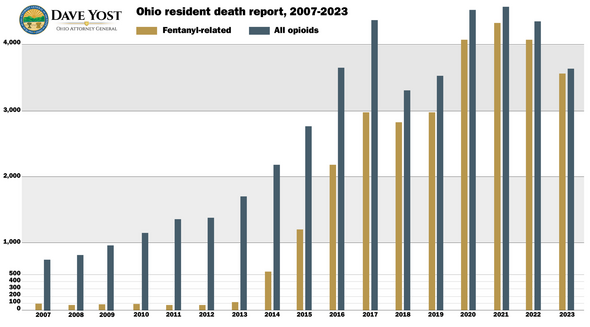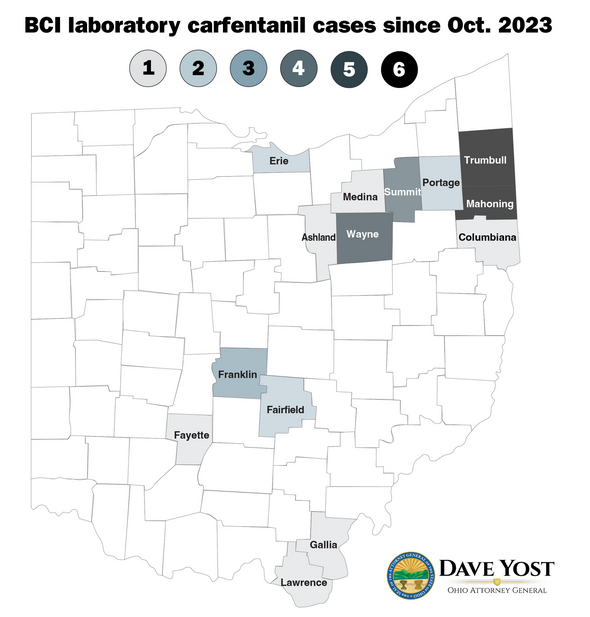COLUMBUS, Ohio) — On a day set aside to raise awareness nationally about fentanyl-related overdose deaths, Ohio Attorney General Dave Yost released data from the Bureau of Criminal Investigation’s laboratory highlighting the ongoing prevalence of the synthetic opioid in Ohio.
“Illegal use of fentanyl continues to wreck Ohioans’ lives, causing addiction and death,” Yost said. “Unless the pills you’re taking were prescribed by your doctor, you can’t be sure what it is – don’t risk it.”
Three years ago, the U.S. Drug Enforcement Administration (DEA) established May 7 as National Fentanyl Awareness Day, an effort to educate Americans about the public health crisis that illegal fentanyl poses and engage them in the fight to prevent more tragic deaths.
Last year alone, the DEA says, more than 70,000 Americans fatally overdosed on illegally made fentanyl. In Ohio in 2023, the total number of fentanyl-related opioid deaths was 3,579, according to Yost’s Scientific Committee on Opioid Overdose and Prevention Education (SCOPE), which monitors such deaths statewide using Ohio Department of Health data.
Those 3,579 deaths represent 98% of the 3,651 overall opioid fatalities in Ohio last year — reinforcing the breadth of the state’s challenge with illegal fentanyl.
“These numbers are frightening if you look at them as numbers,” Yost added. “They are heartbreaking when you realize they were someone’s loved ones.”

Source: Ohio Department of Health, Ohio Public Health Information Warehouse
Fentanyl update
As the largest criminal drug lab in the state, BCI’s laboratory tests a majority, but not all, of the drug evidence seized by law enforcement agencies in Ohio.
The BCI lab continues to process a high number of cases involving fentanyl, which in the first quarter of 2024 was the second-most-often identified substance in drug-evidence samples (after only methamphetamine). Since 2018, fentanyl has posed an increasingly larger public threat than heroin, whose prevalence has steadily declined in recent years.

Fentanyl is manufactured for doctors to control patients’ pain within a controlled environment. When fentanyl is illicitly manufactured in clandestine laboratories and mixed with other substances by drug traffickers — and/or used recreationally — it can be lethal.
Illicitly manufactured fentanyl often contains forms of fentanyl whose structure is chemically modified, making their potency and toxicity unknown. To date, BCI has identified at least 33 distinct versions of chemically modified fentanyl.
Fentanyl can be found in many forms, including pills and powder, and is often combined by traffickers with heroin, cocaine and/or other drugs. When consumed, complex mixtures of drugs can create dangerous interactions in the body, amplifying the danger. One sample recently analyzed by BCI contained 11 controlled substances.
Carfentanil update
Carfentanil, a fentanyl analogue that is roughly 100 times more potent than fentanyl and 10,000 times more potent than morphine, continues its ongoing presence in Ohio.
The drug was first detected in Ohio drug samples in 2016 and caused a spike in overdoses in 2017. Five years later, the public threat posed by carfentanil seemed to be abating, with BCI’s lab identifying the drug in only five samples in all of 2022.
In September of last year, however, AG Yost issued a warning about an uptick in carfentanil prevalence. Since Oct. 23, the BCI lab has identified a combined 36 items containing carfentanil in 14 counties, with the majority of those seized in northeastern Ohio.

Carfentanil is often found with other drugs and has been identified in market tablets and powders, including those similar in appearance to materials used to manufacture oxycodone tablets.
Safety
If you believe you have been exposed to fentanyl or carfentanil, you should seek immediate medical attention and notify law enforcement.
Law enforcement officers and first responders should wear proper personal protective equipment and use caution in handling evidence suspected of containing carfentanil or any fentanyl-related substance, particularly in cases where an overdose has occurred.
Media Resources
Hear from the AG
Photographs of fentanyl evidence samples
MEDIA CONTACT:
Steve Irwin: 614-728-5417
-30-